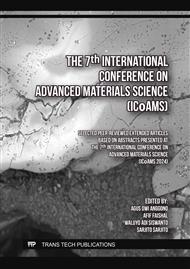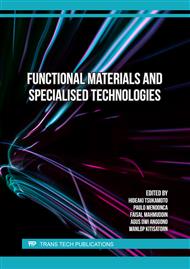[1]
Wakabayashi, K., Sasaki, K. I., Nakanishi, T., & Enoki, T. (2010). Electronic states of graphene nanoribbons and analytical solutions. Science and technology of advanced materials, 11(5), 054504.
DOI: 10.1088/1468-6996/11/5/054504
Google Scholar
[2]
Dutta, S., & Pati, S. K. (2010). Novel properties of graphene nanoribbons: a review. Journal of Materials Chemistry, 20(38), 8207-8223.
DOI: 10.1039/c0jm00261e
Google Scholar
[3]
Marmolejo-Tejada, J. M., & Velasco-Medina, J. (2016). Review on graphene nanoribbon devices for logic applications. Microelectronics Journal, 48, 18-38.
DOI: 10.1016/j.mejo.2015.11.006
Google Scholar
[4]
Chen, Z., Narita, A., & Müllen, K. (2020). Graphene nanoribbons: on‐surface synthesis and integration into electronic devices. Advanced Materials, 32(45), 2001893.
DOI: 10.1002/adma.202001893
Google Scholar
[5]
Chung, H. C.; Chang, C. P.; Lin, C. Y.; Lin, M. F. (2016). "Electronic and optical properties of graphene nanoribbons in external fields". Physical Chemistry Chemical Physics. 18 (11): 7573–7616.
DOI: 10.1039/c5cp06533j
Google Scholar
[6]
Son Y.-W.; Cohen M. L.; Louie S. G. (2006). "Energy Gaps in Graphene Nanoribbons". Physical Review Letters. 97 (21): 216803.
DOI: 10.1103/physrevlett.98.089901
Google Scholar
[7]
Jung. J.; Pereg-Barnea T.; MacDonald A. H. (2009). "Theory of Interedge Superexchange in Zigzag Edge Magnetism". Physical Review Letters. 102 (22): 227205.
DOI: 10.1103/physrevlett.102.227205
Google Scholar
[8]
Lin, Ming-Fa; Shyu, Feng-Lin (2000). "Optical Properties of Nanographite Ribbons". J. Phys. Soc. Jpn. 69 (11): 3529.
DOI: 10.1143/jpsj.69.3529
Google Scholar
[9]
Hsu, Han; Reichl, L.E. (2007). "Selection rule for the optical absorption of graphene nanoribbons". Phys. Rev. B. 76 (4): 045418.
DOI: 10.1103/physrevb.76.045418
Google Scholar
[10]
Raifee, Mohammad; Wei Lu; Abhay V. Thomas; Ardavan Zandiatashbar; Javad Rafiee; James M. Tour (16 November 2010). "Graphene nanoribbon composites". ACS Nano. 4 (12): 7415–7420.
DOI: 10.1021/nn102529n
Google Scholar
[11]
Song, Y.L., Zhang, Y., Zhang, J. M., & Lu, D. B. (2010). Effects of the edge shape and the width on the structural and electronic properties of silicene nanoribbons. Applied Surface Science, 256(21), 6313-6317.
DOI: 10.1016/j.apsusc.2010.04.009
Google Scholar
[12]
Trivedi, S., Srivastava, A., & Kurchania, R. (2014). Electronic and transport properties of silicene nanoribbons. Journal of Computational and Theoretical Nanoscience, 11(3), 789-794.
DOI: 10.1166/jctn.2014.3429
Google Scholar
[13]
Ferri, M., Fratesi, G., Onida, G., & Debernardi, A. (2019). Ab initio study of the structural, electronic, magnetic, and optical properties of silicene nanoribbons. Physical Review B, 99(8), 085414.
DOI: 10.1103/physrevb.99.085414
Google Scholar
[14]
Zhao, Y.C., & Ni, J. (2014). Spin-semiconducting properties in silicene nanoribbons. Physical Chemistry Chemical Physics, 16(29), 15477-15482.
DOI: 10.1039/c4cp01549e
Google Scholar
[15]
Luan, H. X., Zhang, C. W., Zheng, F. B., & Wang, P. J. (2013). First-principles study of the electronic properties of B/N atom doped silicene nanoribbons. The Journal of Physical Chemistry C, 117(26), 13620-13626.
DOI: 10.1021/jp4005357
Google Scholar
[16]
Ma, L., Zhang, J.M., Xu, K.W., & Ji,V. (2013). Structural and electronic properties of substitutionally doped armchair silicene nanoribbons. Physica B: Condensed Matter, 425, 66-71.
DOI: 10.1016/j.physb.2013.05.022
Google Scholar
[17]
Zheng, F.B., Zhang, C.W., Yan, S. S., & Li, F. (2013). Novel electronic and magnetic properties in N or B doped silicene nanoribbons. Journal of Materials Chemistry C, 1(15), 2735-2743.
DOI: 10.1039/c3tc30097h
Google Scholar
[18]
Tien, Tran Minh. (2023), "Research on the structural and electronic properties of silicene nanoribbon material adsorpted lithium." Materials Today: Proceedings .
DOI: 10.1016/j.matpr.2023.06.297
Google Scholar
[19]
Tien, Tran Minh. (2024),"Adsorption of alkaline metals (Li, Na, K) on armchair silicene nanoribbons." Materials Today: Proceedings.
DOI: 10.1016/j.matpr.2024.04.077
Google Scholar
[20]
Zhang, J.M., Zheng, F. L., Zhang, Y., & Ji, V. (2010). First-principles study on electronic properties of SiC nanoribbon. Journal of materials science, 45, 3259-3265.
DOI: 10.1007/s10853-010-4335-5
Google Scholar
[21]
Alaal, N., Loganathan, V., Medhekar, N., & Shukla, A. (2016). First principles many-body calculations of electronic structure and optical properties of SiC nanoribbons. Journal of Physics D: Applied Physics, 49(10), 105306.
DOI: 10.1088/0022-3727/49/10/105306
Google Scholar
[22]
Zhang, J. M., Song, W. T., Zhang, J., & Xu, K. W. (2014). Dangling bond modulating the electronic and magnetic properties of zigzag SiGe nanoribbon. Physica E: Low-dimensional Systems and Nanostructures, 58, 1-5.
DOI: 10.1016/j.physe.2013.11.009
Google Scholar
[23]
Saraswat, V., Yamamoto, Y., Kim, H. J., Jacobberger, R. M., Jinkins, K. R., Way, A. J., ... & Arnold, M. S. (2019). Synthesis of armchair graphene nanoribbons on germanium-on-silicon. The Journal of Physical Chemistry C, 123(30), 18445-18454.
DOI: 10.1021/acs.jpcc.9b04390
Google Scholar
[24]
Damizadeh, S., Nayeri, M., Kalantari Fotooh, F., & Fotoohi, S. (2020). Electronic and Optical Properties of SnGe and SnC Nanoribbons: A First-Principles Study. Journal of Optoelectronical Nanostructures, 5(4), 67-86.
DOI: 10.1088/2053-1591/ab2a5a
Google Scholar
[25]
Somaiya, R. N., Sonvane, Y. A., & Gupta, S. K. (2020). Exploration of the strain and thermoelectric properties of hexagonal SiX (X= N, P, As, Sb, and Bi) monolayers. Physical Chemistry Chemical Physics, 22(7), 3990-3998.
DOI: 10.1039/d0cp00002g
Google Scholar
[26]
G. Kresse and J. Furthmüller, Efficiency of ab-initio total energy calculations for metals and semiconductors using a plane-wave basis set, Comput. Mater. Sci., 6 (1996.)1.
DOI: 10.1016/0927-0256(96)00008-0
Google Scholar
[27]
G. Kresse and J. Furthmüller, Efficient iterative schemes for ab initio total-energy calculations using a plane-wave basis set, Phys. Rev. B. 54 (1996)16.
DOI: 10.1103/physrevb.54.11169
Google Scholar
[28]
J. P. Perdew, K. Burke, and M. Ernzerhof, Generalized gradient approximation made simple, Phys. Rev. Lett. 77 (1996) 18.
DOI: 10.1103/physrevlett.77.3865
Google Scholar
[29]
G. Kresse and D. Joubert, From ultrasoft pseudopotentials to the projector augmented-wave method, Phys. Rev. B. 59 (1999)
DOI: 10.1103/physrevb.59.1758
Google Scholar



